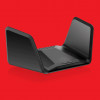4.6Gbps Wi-Fi: How 60GHz wireless works—and should you use it?
There's a new Wi-Fi standard in town, and it takes speed to another level. 802.11ad Wi-Fi is rated for data throughput up to 4,600Mbps, or four times faster than the current speed champ 802.11ac. That's much faster than standard gigabit Ethernet and most home broadband speeds, although—as any Wi-Fi user knows—there's a big difference between theoretical speed and what's possible in practice. Still, want to stream high-bitrate 4K, HDR films over Wi-Fi? That won't be a problem with 802.11ad. Even the best triple-layer UHD Blu-rays top out at 128Mbps bitrates. There's even a chance it could make high-end wireless virtual reality headsets more practical.
802.11ad will at first be available via a new wave of home routers, a couple of which have already hit the shelves: the Netgear Nighthawk X10 and the TP-Link Talon AD7200. As ever with brand-new tech, the routers demand a hefty premium, with the AD7200 costing an eye-watering £350/$360—that's as much as even sophisticated mesh-based systems like the Ubiquiti Amplifi. Is 802.11ad Wi-Fi worth the cost? Is there anything you can even reasonably use it for right now? Or should you hold out for the inevitable price drops? Let's find out.










































































